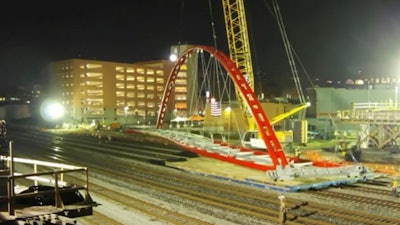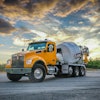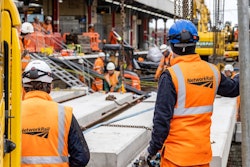
The City of Emeryville, California has been planning a pedestrian-bicycle bridge to better connect trails and parks, and to avoid busy vehicle traffic.
The bridge was lifted into place in December 2020 by crews who worked for three days on the delicate operation of moving the structure. Watch the time lapse video:
Biggs Cardosa Associates, HNTB, Callander & Associates, MNS Engineers and Ghilotti Construction are working on the $21.4 million project.
History of the Project
- The bridge has been in the Emeryville General Plan since the 1980s, with the plan to provide a safe pedestrian-bicycle connection linking the east and west sides of the city over the railroad tracks.
- Project development started in 2002 as the Emeryville Redevelopment Agency Project – Architectural Design.
- Environmental review took place in 2008.
- Engineering design started in 2009.
- Project halted with the California Deauthorization of Redevelopment Agencies.
- City sued California for project funds of $12 million; returned in 2014.
- Project reactivated in 2015
- Right-of-way negotiations completed from 2015 through early 2019.
- Contractor pre-qualification process in early 2018.
- Construction contract bid and awarded in mid 2019.
- Construction commenced in January 2020 and anticipated to be complete by fall 2021.
Bridge Fabrication Details
- The signature feature of the project, the arch span, is comprised of materials and components fabricated in three continents and six states.
- Cables were fabricated in Switzerland and cable sockets were fabricated in Houston, Texas. The cables were fully assembled in Montreal, Canada.
- Bridge fabrication was performed in Arizona and initial assembly completed there at the end of October.
- The bridge deck and arch components were shipped by truck to Horton Landing Park in early November.
- Assembly of the bridge arch structure was completed in mid-December. Deck and arch components were welded and bolted together, and temporary towers were used to ensure the appropriate geometries to conform to the design.
Bridge Lift
Due to constraints of working over an active railway corridor the bridge was assembled outside of the Union Pacific Right of Way and lifted into place over the tracks. The bridge lift is a delicate operation and requires significant preparation to prepare and perform the lift. Operation to complete this activity culminated in a 3-day continuous effort working 24 hours a day to ensure a safe and efficient operation with minimal impact to train operations.
The bridge lift required months of preparation:
- Realignment of some utilities and site preparation were initially performed.
- Construction of bridge abutments on both the east and west sides, including driven piles to support the structure, were installed.
- Preparation for the lift required placement of crane mats and steel plates to support the cranes and provide an even surface for the cranes to travel on to move the bridge.
- Erection of the cranes and balancing of the bridge load was performed.
- UPRR restricted train traffic for an approximate 4-hour window on the night of Saturday, December 19 to allow the construction team access to the railroad right of way.
- The bridge was lifted and moved into place during the first 1.5 hours of the window and structurally secured immediately thereafter with crane support. The cranes and cranes mats and plates were then removed from the UPRR track area, and train traffic was restored to service prior to early morning on Sunday, December 20.
COVID-19 Challenges
The advancement of this project has continued through the COVID-19 Pandemic shelter-in-place order. The City and the Contractor are working together to conform to the latest Health Orders issued by Alameda County and the State of California to minimize infection risks to workers, residents, and the general public.
The pandemic has impacted the project in supply chain delays. The contractor and the City have worked together to minimize delays through schedule and sequence of work modifications.
Read more about the project on the city's website.



















